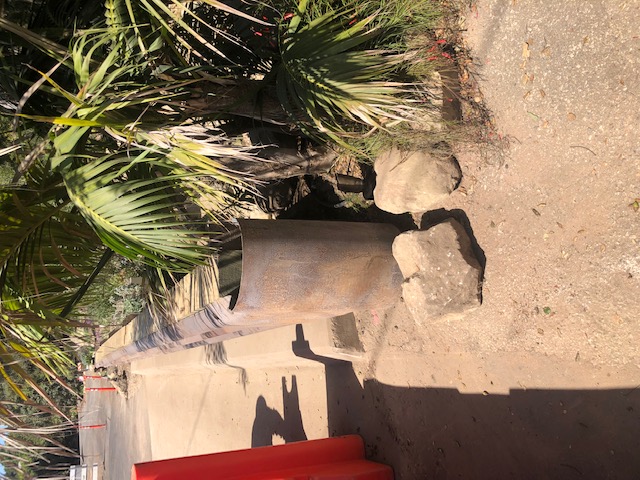Right-of-Way Rules
Knowing where your property ends and where roads begin can be confusing. The Montecito Association has received some calls about easements and encroachments and realized it might be a good idea to write about roads, bridges, and other related topics.

Road right-of-way is dedicated when property maps are created to allow space for the County, State, or other agencies (utilities, flood control districts, etc.) to provide services to your property and the community. These areas are used to provide room for roads, drainage, utilities, shoulder recovery zones, walking/biking areas, signs, and other needs that may arise as areas develop.
Rights-of-way can be a little confusing because some maps may show your property extending roughly to the middle of the road. That is because in some cases the road right-of-way is an easement, which means the adjacent property owner still owns the underlying property, but the public has the right to access it for the purposes described above. In other cases, an agency may own the physical property the road and shoulders cover. In that case, it is called “fee” owned right-of-way.
Alignments and widths of rights-of-way can differ. One property could have a right-of-way that’s 15 feet or more from the edge of the road shoulder, while another could be very near the edge of the paved road. It’s important to know where the right-of-way is because future projects could impact your property. Also, any improvements in the road right-of-way should have a road encroachment permit, regardless of whether it is an easement or owned by the agency in fee. If you have fencing, landscape planting, or stones at the edge of your property, they might be encroaching in the right-of-way. When a planned shoulder trail goes in on Olive Mill Road, for example, the current plan is to shift the street a few feet to the west and install a path on the east of the road. This could include the removal of some items that encroached in the right-of-way.
Santa Barbara County Public Works Deputy Director Chris Sneddon says the County carefully decides how to use the right-of-way for improvements or repairs, and takes care to minimize impacts to adjacent properties. Public Works sometimes receives requests asking the County to force someone to move things out of the right-of-way. Chris says, “We generally don’t move things unless it’s causing an issue. People want to be able to walk in the right-of-way or use it as a public space. But some of the trees and fences in the right-of-way may have been there for 50 years or more, without permits. A present owner may not even be aware of it, especially if it was planted years ago before they acquired it.” In these cases, the County seeks to balance the needs of the community with the individual property owner’s desires to maintain their frontage improvements.
So when do you need to get an encroachment permit to use the County’s right-of-way? You need it for things like landscaping, fencing, boulders, mailboxes, and walls. Chris says, “pretty much anything in the right-of-way should have a permit.” To get a permit to use the right-of-way, residents can visit the County’s Encroachment Permits office at 4417 Cathedral Oaks or call (805) 681-4990.
Reconstructing Bridges
I also spoke with Chris about bridge reconstruction, and why new bridges might look so different from what was there before. Chris said the County and CalTrans are still reconstructing bridges damaged during the 1/9 debris flow. “Sometimes, the new bridge construction can cause a shock to neighbors who were long used to the old one. The reason for this is the codes have changed since the original bridges were constructed, and the codes now require things like bigger guard rails and other improvements.” For example, at an old bridge up Alisos Drive the guardrails are quite low and made from wood.
The railing would usually be left as is, even though it’s out-of-date with current codes. However, the bridge rails further down on Alisos Road were destroyed in 1/9 and require replacement. When new replacement work is done, they must be built to current standards. That includes new, more robust codes that replace the rails with larger and stronger elements. Even so, the new railing the County is installing on the Alisos Drive bridge is the minimal size the County could install. And the rust color is a more expensive treatment than the galvanized grey steel that is standard. Chris said the rust color “is meant to blend in more with the community. This finish is called weathering steel, or Natina, and it also matches what Caltrans is using on East Valley Road.” These treatments came out of community input for past projects, such as the pedestrian bridge near the YMCA and the bridges on North Jameson Lane between San Ysidro Road and Sheffield Drive. Here’s an example from the Alisos Drive bridge rails – these are the new ones.
The County published an information pamphlet on rights-of-way, encroachments, and where the clear-zone is. Chris is providing the Montecito Association with some, and we’re happy to give them to you. Just visit our office at 1469 East Valley Road, Mondays through Thursdays from 9 am to 2 pm. Questions? Call us at (805) 969-2626.







You must be logged in to post a comment.